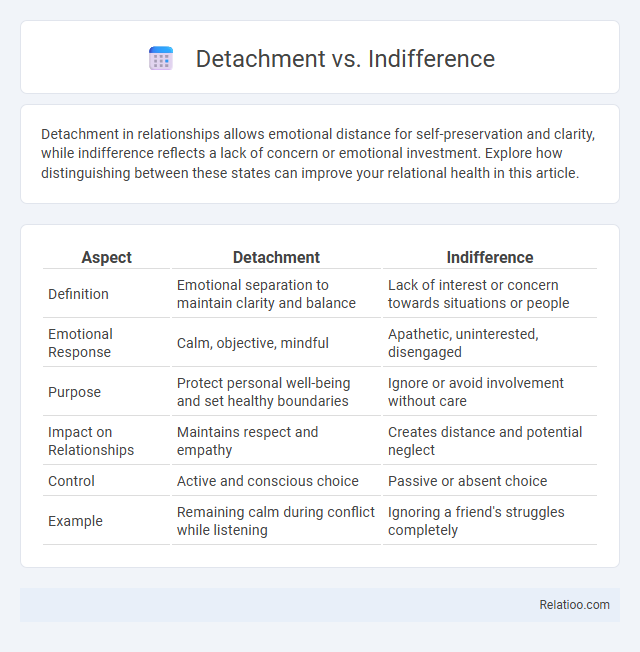Detachment in relationships allows emotional distance for self-preservation and clarity, while indifference reflects a lack of concern or emotional investment. Explore how distinguishing between these states can improve your relational health in this article.
Table of Comparison
| Aspect | Detachment | Indifference |
|---|---|---|
| Definition | Emotional separation to maintain clarity and balance | Lack of interest or concern towards situations or people |
| Emotional Response | Calm, objective, mindful | Apathetic, uninterested, disengaged |
| Purpose | Protect personal well-being and set healthy boundaries | Ignore or avoid involvement without care |
| Impact on Relationships | Maintains respect and empathy | Creates distance and potential neglect |
| Control | Active and conscious choice | Passive or absent choice |
| Example | Remaining calm during conflict while listening | Ignoring a friend's struggles completely |
Understanding Detachment: A Balanced Perspective
Understanding detachment involves recognizing it as a balanced state where you maintain emotional distance without losing empathy or interest in the situation. Unlike indifference, which implies apathy and lack of concern, detachment allows for clear judgment and calm decision-making. Your ability to practice healthy detachment fosters emotional resilience while preserving meaningful connections.
Defining Indifference: Absence of Emotional Investment
Indifference is characterized by the absence of emotional investment, where an individual shows neither concern nor attachment to a person, situation, or outcome. Unlike detachment, which involves a conscious choice to maintain emotional distance for clarity or self-protection, indifference reflects apathy and lack of engagement. This emotional absence often results in passive responses and diminished motivation to act or empathize.
Key Differences Between Detachment and Indifference
Detachment involves maintaining emotional distance to preserve clarity and objectivity, while indifference reflects a lack of concern or interest, often leading to apathy. Your ability to practice detachment allows for healthy boundaries and mindful decision-making, whereas indifference can hinder emotional connections and reduce empathy. Understanding these key differences is essential for cultivating balanced relationships and personal well-being.
Emotional Impact: Detachment vs Indifference
Detachment involves maintaining emotional boundaries to protect your well-being while still acknowledging your feelings, leading to balanced emotional impact. Indifference signifies a lack of interest or concern, often resulting in emotional numbness or disconnection from people and situations. Understanding these distinctions helps you manage emotional responses effectively, preserving mental health without becoming emotionally disengaged.
Healthy Boundaries: The Role of Detachment
Detachment plays a crucial role in establishing healthy boundaries by allowing you to maintain emotional balance without becoming overly involved in others' problems. Unlike indifference, detachment fosters compassion and understanding while protecting your well-being from emotional exhaustion. Developing healthy detachment helps you create respectful limits that support your mental health and interpersonal relationships.
Risks and Consequences of Indifference
Indifference can lead to emotional numbness, impairing Your ability to connect with others and respond appropriately to important situations, which may result in social isolation and missed opportunities for growth. Unlike detachment, which fosters healthy boundaries and emotional regulation, indifference risks apathy and a lack of empathy, increasing vulnerability to misunderstandings and relationship breakdowns. Prolonged indifference often causes diminished motivation and a decline in mental well-being, highlighting the critical importance of recognizing and addressing this harmful state.
The Psychological Roots of Both States
Detachment originates from a conscious decision to maintain emotional balance by recognizing and accepting feelings without becoming overwhelmed, often rooted in mindfulness practices and self-regulation skills. Indifference stems from emotional numbing or defensive mechanisms, where lack of interest or concern serves as a psychological barrier to protect against pain or stress. Both states involve distancing from emotional engagement but differ fundamentally in awareness and intent, with detachment emphasizing adaptive control and indifference reflecting emotional disengagement or avoidance.
Cultivating Detachment Without Losing Empathy
Cultivating detachment allows you to maintain emotional balance while remaining empathetic, preventing burnout and fostering clear judgment. Unlike indifference, which implies apathy and disconnection, detachment involves conscious emotional regulation without losing compassion for others. Developing this skill enhances your ability to support others effectively while protecting your own mental well-being.
Indifference in Relationships: Warning Signs
Indifference in relationships manifests as a lack of emotional response, diminished communication, and a persistent sense of apathy towards a partner's needs. Warning signs include ignoring important conversations, avoiding intimacy, and showing no concern during conflicts or emotional moments. Recognizing these behaviors is crucial, as indifference can erode trust and intimacy faster than detachment, which often involves intentional emotional boundaries.
Choosing Growth: Transforming Indifference into Constructive Detachment
Choosing growth involves transforming indifference, which reflects emotional disengagement and apathy, into constructive detachment, a mindful state that allows you to observe experiences without getting overwhelmed. Constructive detachment fosters emotional resilience and clarity by helping you manage your reactions while maintaining empathy and awareness. This conscious shift empowers your personal development by balancing emotional distance and engagement for healthier relationships and decision-making.

Infographic: Detachment vs Indifference
 relatioo.com
relatioo.com